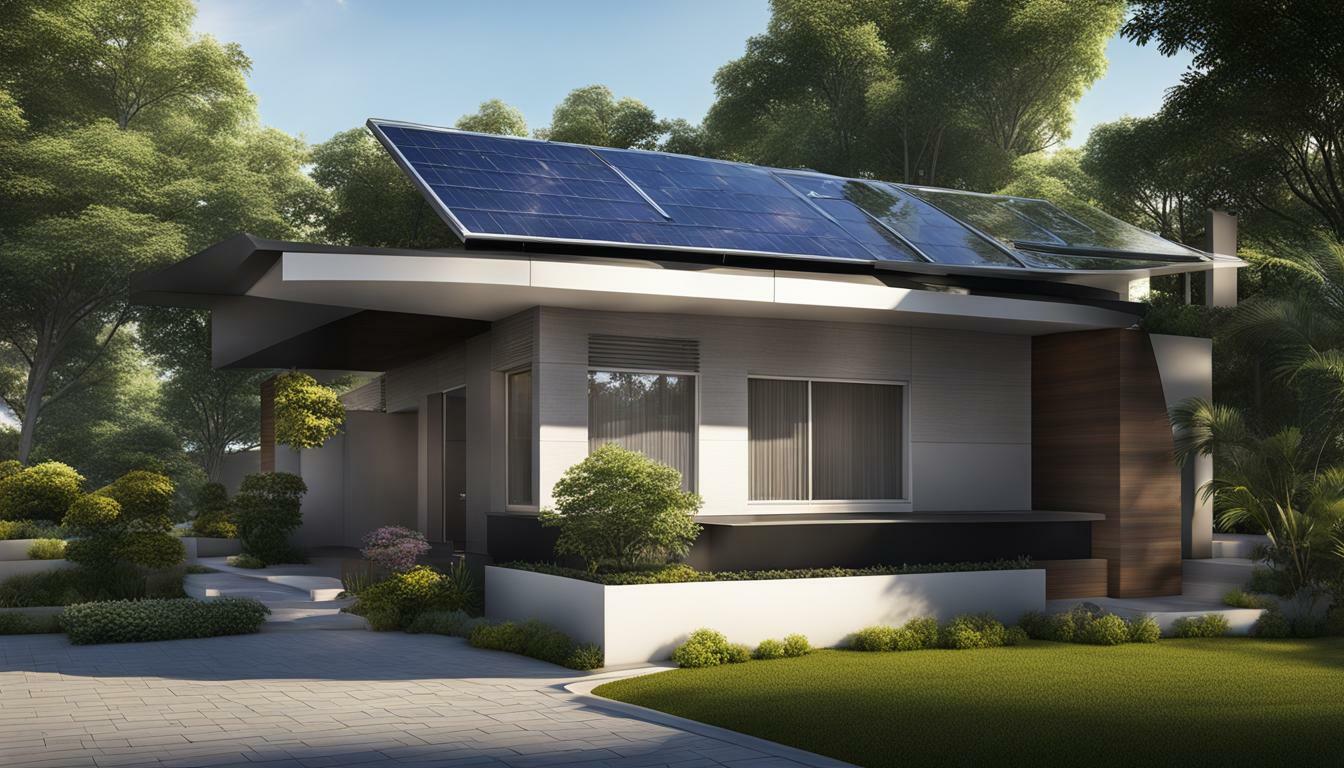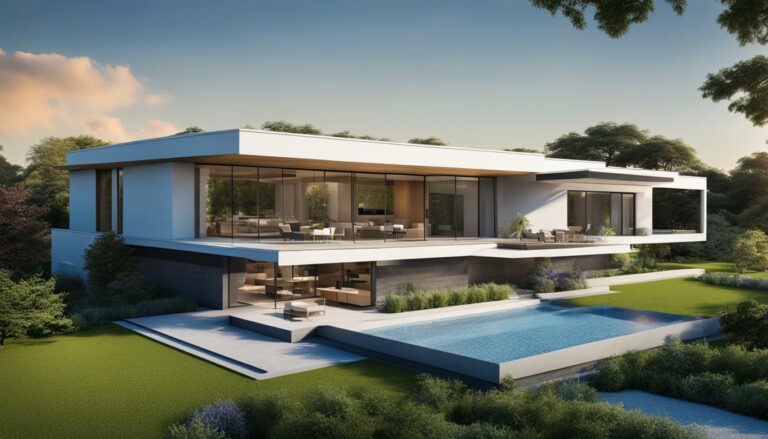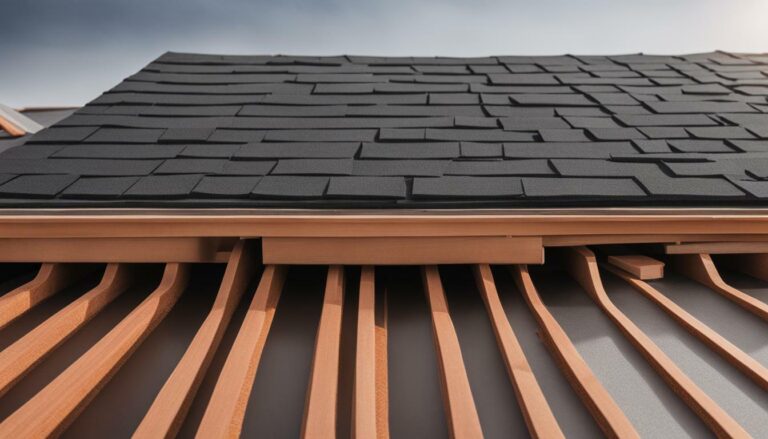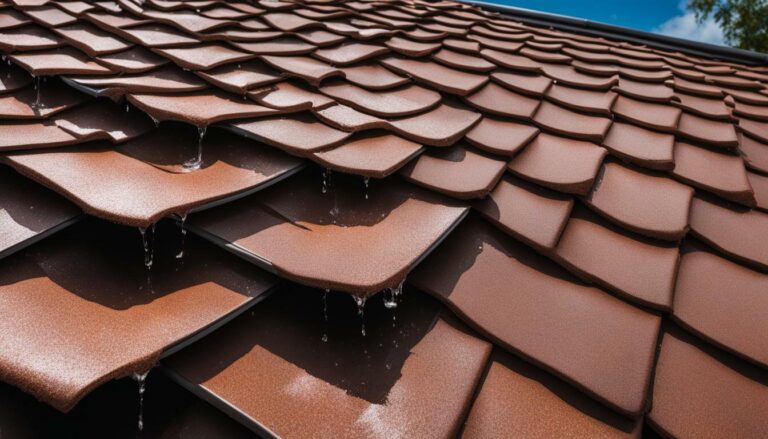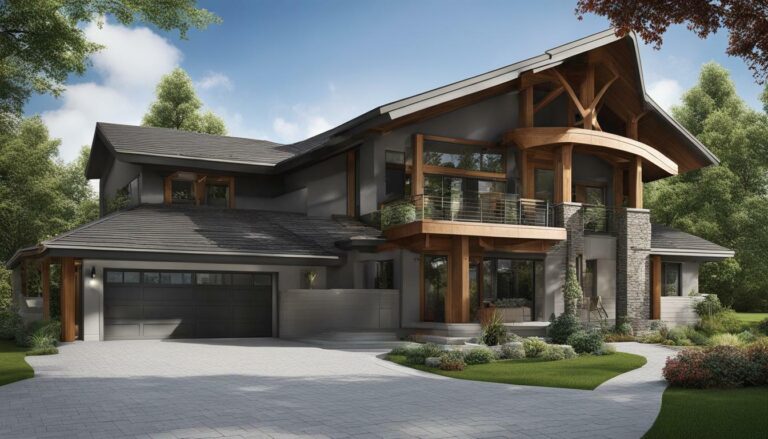Embrace the Future with Cool Roof Technology Today
Discover how cool roof technology can lower energy bills and combat climate change while promoting sustainable living. The evolution of roofing has brought exciting advancements, from smart roofs with sensors and Wi-Fi connectivity to heated roofs that keep your feet warm. Solar roofs are also gaining popularity, harnessing the power of the sun to generate renewable energy. High-tech roof insulation helps keep your home cool in the summer. Stay on top of your roofing game with cutting-edge tools like the Roof-Dazzler 3000 and the Turbo-Nailer 5000. Upgrade your roofing materials with sustainable options like metal, clay tiles, and cool roofs. Green roofs and living walls are also trending, providing numerous benefits like improved air quality and insulation. Cool roofs play a crucial role in reducing the urban heat island effect and saving energy. They reflect sunlight and absorb less heat, leading to lower energy consumption, improved indoor comfort, and extended roof lifespan. Cool roofs also contribute to reduced peak energy demand, enhanced air quality, and greener cities. When implementing cool roofs, consider the specific needs and climate of the location. Embrace cool roof technology and create a sustainable and energy-efficient future.
Key Takeaways:
- Cool roof technology offers a range of benefits, including lower energy bills and reduced environmental impact.
- Advancements in roofing technology, such as smart roofs and heated roofs, provide enhanced functionality and comfort.
- Sustainable roofing materials, like metal roofs and clay tiles, contribute to energy efficiency and long-term durability.
- Green roofs and living walls offer aesthetic appeal while improving air quality and providing insulation.
- Cool roofs reduce the urban heat island effect, lower energy consumption, and contribute to greener cities.
The Advancements in Roofing Technology
The evolution of roofing has brought exciting advancements, from smart roofs with sensors and Wi-Fi connectivity to heated roofs that keep your feet warm. Solar roofs are also gaining popularity, harnessing the power of the sun to generate renewable energy. High-tech roof insulation helps keep your home cool in the summer. Stay on top of your roofing game with cutting-edge tools like the Roof-Dazzler 3000 and the Turbo-Nailer 5000.
Smart roofs are revolutionizing the way we interact with our homes. With sensors embedded in the roof, you can monitor the temperature, detect leaks, and even receive real-time weather updates. Wi-Fi connectivity allows you to control your roof’s settings remotely, making it easier to adjust ventilation and temperature settings. These smart roofs not only provide convenience but also contribute to energy efficiency by optimizing your home’s climate control.
“The Roof-Dazzler 3000 and the Turbo-Nailer 5000 are game-changers in the roofing industry. These advanced tools make roof installation and maintenance faster and more efficient, ensuring impeccable results. With the Roof-Dazzler 3000, you can easily apply a reflective cool roof coating, reducing heat absorption and lowering energy consumption. The Turbo-Nailer 5000 is designed for precision and speed, making roof installation a breeze.”
Solar roofs are another exciting advancement in the roofing field. These roofs are equipped with solar panels that generate electricity from sunlight, reducing your reliance on traditional power sources. By harnessing the power of the sun, solar roofs contribute to a greener and more sustainable future. Furthermore, high-tech roof insulation, such as foam and reflective materials, provides superior thermal performance, keeping your home cool in the summer and reducing energy costs.
| Advancements in Roofing Technology | |
|---|---|
| Smart Roofs | Sensors, Wi-Fi connectivity, energy efficiency |
| Heated Roofs | Warmth, comfort |
| Solar Roofs | Renewable energy, sustainability |
| High-Tech Roof Insulation | Thermal performance, energy savings |
The advancements in roofing technology have transformed the way we think about roofs. With smart roofs, heated roofs, solar roofs, and high-tech roof insulation, homeowners can enjoy enhanced comfort, energy efficiency, and sustainability. By embracing these innovations and utilizing advanced tools, you can ensure that your roof is not only functional but also a cutting-edge feature of your home.
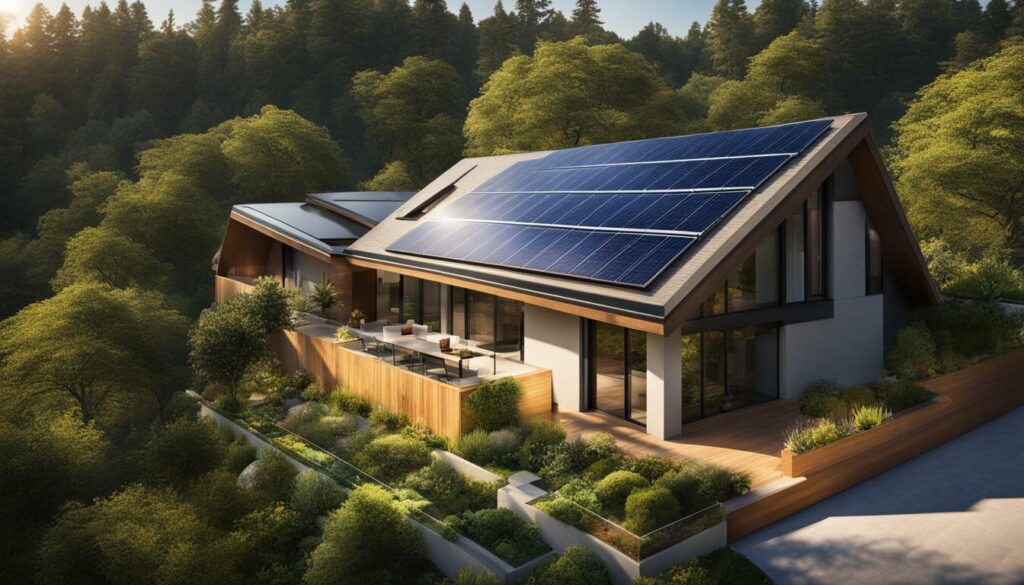
Innovative Tools for Roofing
Stay on top of your roofing game with cutting-edge tools like the Roof-Dazzler 3000 and the Turbo-Nailer 5000. These advanced tools are revolutionizing the roofing industry, making installation and maintenance more efficient and effective than ever before.
“The Roof-Dazzler 3000 is a game-changer in roof installation. Its state-of-the-art technology ensures precise placement of shingles, reducing errors and minimizing time spent on each project.” – John Thompson, Roofing Contractor
The Roof-Dazzler 3000 is equipped with advanced sensors and a user-friendly interface, allowing roofers to achieve optimal results with ease. Its high-speed installation capability and built-in error detection system ensure a seamless and precise installation process.
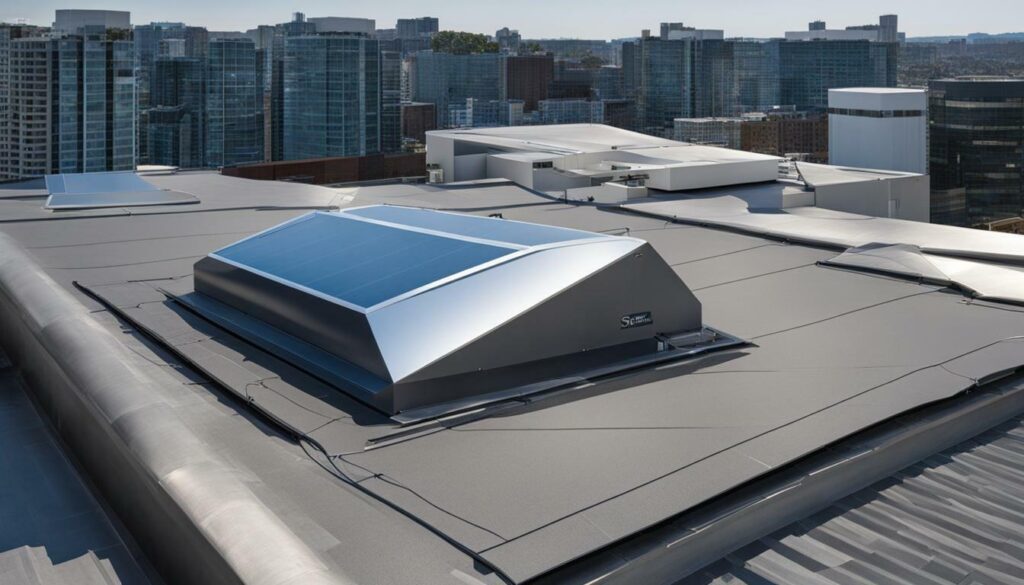
The Turbo-Nailer 5000 is another must-have tool for roofing professionals. Its powerful pneumatic system allows for fast and secure fastening of roofing materials, increasing productivity and reducing installation time.
The Benefits of Using Innovative Tools
- Improved Efficiency: With the Roof-Dazzler 3000 and Turbo-Nailer 5000, roofers can complete projects faster and with greater accuracy, saving both time and money.
- Enhanced Quality: These advanced tools ensure precise installation, resulting in a long-lasting and durable roof that can withstand various weather conditions.
- Increased Safety: The Roof-Dazzler 3000 and Turbo-Nailer 5000 are designed with safety features to protect workers from potential hazards, promoting a safe working environment.
Investing in innovative tools is an investment in the future of roofing. By utilizing the Roof-Dazzler 3000 and Turbo-Nailer 5000, roofers can elevate their craftsmanship, provide exceptional service, and stay ahead of the competition in this ever-evolving industry.
| Tool | Features | Benefits |
|---|---|---|
| Roof-Dazzler 3000 | – Advanced sensors – User-friendly interface – High-speed installation capability – Error detection system |
– Precise and seamless installation – Time-saving – Minimized errors |
| Turbo-Nailer 5000 | – Powerful pneumatic system – Fast and secure fastening – Increased productivity – Reduced installation time |
– Efficient and quick installation – Time-saving – Secure and durable fastening |
Sustainable Roofing Materials
Upgrade your roofing materials with sustainable options like metal, clay tiles, and cool roofs. These environmentally-friendly choices offer a range of benefits, from energy efficiency to long-lasting durability.
Metal roofs are a popular sustainable option due to their impressive lifespan and recyclability. They are highly durable, resistant to extreme weather conditions, and have a low maintenance requirement. Metal roofs also reflect sunlight, reducing the amount of heat absorbed into the building and lowering energy consumption.
Clay tiles are another sustainable choice that has been used for centuries. They are made from natural clay and provide excellent insulation properties, keeping your home cool in the summer and warm in the winter. Clay tiles are fire-resistant, long-lasting, and can be recycled at the end of their lifespan.
Cool roofs, on the other hand, are designed to reflect more sunlight and absorb less heat compared to traditional roofing materials. They are typically made with highly reflective materials or have a special coating that enhances their reflective properties. Cool roofs help reduce the urban heat island effect, lower energy consumption for cooling, improve indoor comfort, and extend the lifespan of the roof. They are an excellent choice for areas with hot climates or high energy demand.
Comparison of Sustainable Roofing Materials
| Roofing Material | Benefits |
|---|---|
| Metal Roofs | Durable, recyclable, energy-efficient |
| Clay Tiles | Excellent insulation, fire-resistant, long-lasting |
| Cool Roofs | Reflective, reduce urban heat island effect, lower energy consumption |
When choosing sustainable roofing materials, consider factors such as local climate, building design, and personal preference. Each material has its unique advantages, so it’s essential to find the best fit for your specific needs.
Upgrade your roof to one of these sustainable options and contribute to a greener future. Enjoy the benefits of energy efficiency, improved insulation, and reduced environmental impact. Choose a roofing material that not only protects your home but also aligns with your commitment to sustainability.
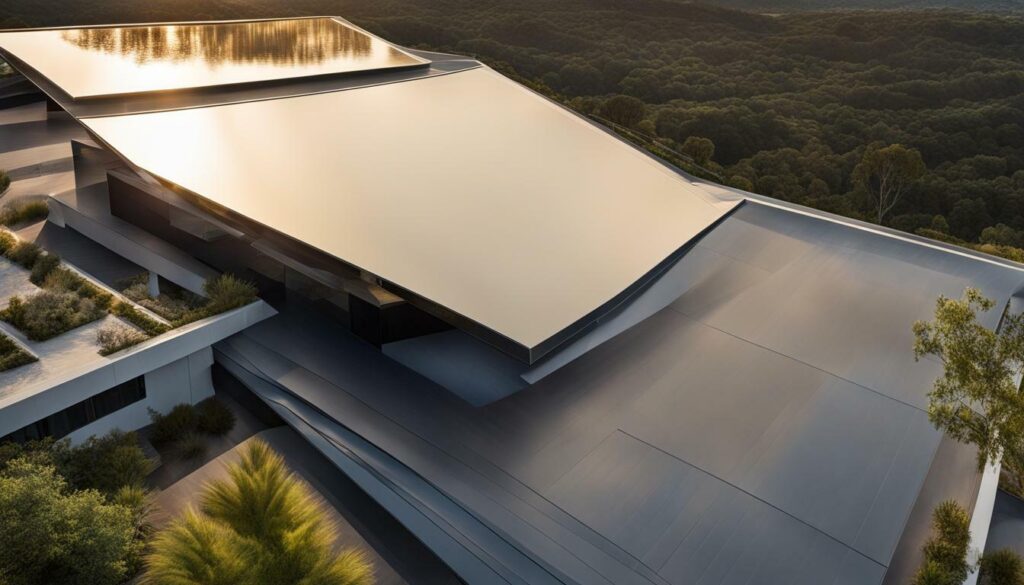
Green Roofs and Living Walls
Green roofs and living walls are also trending, providing numerous benefits like improved air quality and insulation. These innovative solutions not only enhance the aesthetic appeal of buildings but also contribute to a healthier and more sustainable environment. By incorporating vegetation into the design, green roofs and living walls offer a host of advantages that go beyond traditional roofing systems.
One of the key benefits of green roofs is their ability to improve air quality. The plant vegetation acts as a natural filter, removing pollutants and fine dust particles from the air. This helps create a cleaner and healthier atmosphere, especially in urban areas where air pollution is a growing concern. Additionally, green roofs absorb carbon dioxide and release oxygen, further contributing to a cleaner environment.
Another advantage of green roofs and living walls is their insulation properties. The added layer of vegetation helps regulate temperature, reducing heat transfer and providing better thermal insulation. This can lead to lower energy consumption for cooling and heating purposes, resulting in cost savings and reduced carbon emissions.
| Benefits of Green Roofs and Living Walls | Improved Air Quality | Insulation |
|---|---|---|
| Reduces air pollution by acting as a natural filter | Regulates temperature and reduces heat transfer | Improved aesthetic appeal |
| Absorbs carbon dioxide and releases oxygen | Lower energy consumption for cooling and heating | Enhanced biodiversity |
| Enhances the aesthetic appeal of buildings | Cost savings and reduced carbon emissions | Reduced urban heat island effect |
In addition to the environmental benefits, green roofs and living walls also provide aesthetic value to buildings. The vibrant greenery adds a touch of nature to urban landscapes, creating visually pleasing and calming spaces. Furthermore, they promote biodiversity by providing habitats for various plant and animal species, contributing to a healthier ecosystem.

When considering sustainable building designs, green roofs and living walls are excellent options. They not only offer improved air quality, insulation, and aesthetic appeal but also contribute to reducing the urban heat island effect. By embracing these innovative solutions, we can create greener cities and pave the way for a more sustainable future.
Understanding Cool Roofs
Cool roofs play a crucial role in reducing the urban heat island effect and saving energy. They are designed to reflect sunlight and absorb less heat compared to traditional roofs, leading to a cooler indoor environment and several other benefits. By implementing cool roof technology, you can significantly improve your energy consumption, enhance indoor comfort, and extend the lifespan of your roof.
Cool roofs utilize innovative materials and coatings that have high solar reflectance and thermal emittance properties. These features allow them to reflect a large portion of the solar radiation that strikes the roof surface, preventing excessive heat absorption. As a result, your home will experience less heat transfer to the living space, reducing the need for air conditioning and overall energy consumption.
Not only do cool roofs contribute to reducing energy costs, but they also provide a more comfortable indoor environment. By keeping your home cooler, especially during hot summer months, you can enjoy a more pleasant living space. Additionally, the reduced heat absorption helps extend the lifespan of the roof by minimizing thermal expansion and contraction, reducing the risk of damage and deterioration.
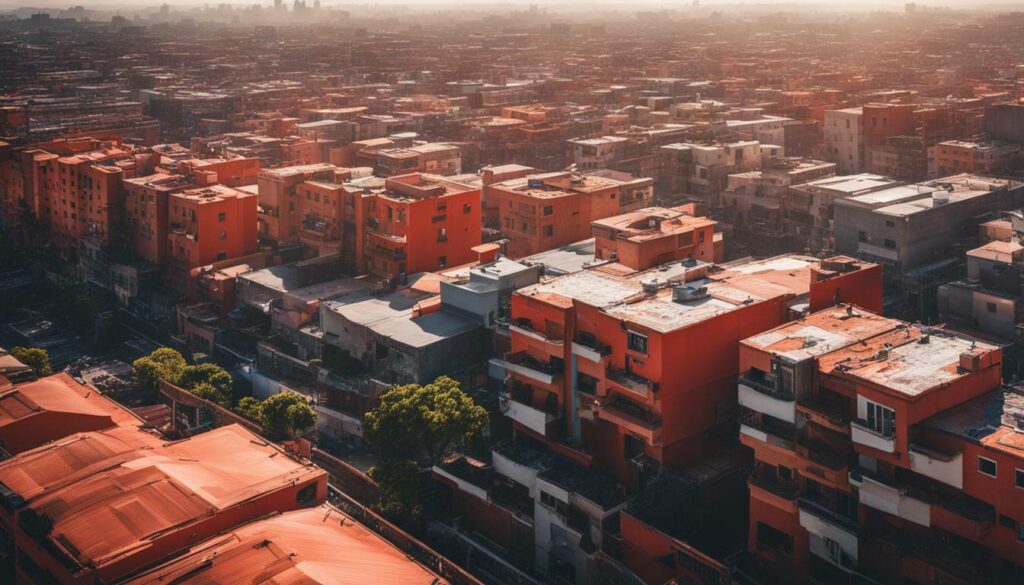
Investing in cool roof technology also has broader benefits for the environment and the community. The urban heat island effect, where cities are significantly warmer than surrounding rural areas due to heat absorption by buildings and concrete, can be mitigated by implementing cool roofs. These roofs help cool down urban areas, reducing the demand for energy-intensive air conditioning and alleviating the heat-related health risks for residents.
By embracing cool roof technology, you are actively contributing to a more sustainable and energy-efficient future. The combination of reduced energy consumption, improved indoor comfort, extended roof lifespan, and the positive impact on the environment makes cool roofs an essential choice for residential and commercial buildings alike. Upgrade your roof today and start enjoying the benefits of cool roof technology!
The Benefits of Cool Roofs
Cool roofs also contribute to reduced peak energy demand, enhanced air quality, and greener cities. By reflecting sunlight and absorbing less heat, cool roofs help to lower the energy consumption of buildings, resulting in reduced peak energy demand. This not only benefits individual homeowners by lowering their energy bills but also has a positive impact on the overall energy grid, reducing the need for additional power generation.
Furthermore, cool roofs improve air quality by reducing the emission of pollutants and greenhouse gases associated with energy production. By reducing the demand for air conditioning, cool roofs also help to decrease the use of refrigerants, which can be harmful to the environment. This leads to cleaner and healthier air for everyone.
Another significant benefit of cool roofs is their contribution to greener cities. By reducing the heat absorbed by buildings, cool roofs mitigate the urban heat island effect, where cities become significantly hotter than the surrounding rural areas. This effect is caused by the extensive use of dark-colored roofing materials and pavement, which absorb and radiate heat. Cool roofs help to counteract this by reflecting sunlight and reducing the heat island effect, making cities more comfortable and sustainable places to live.
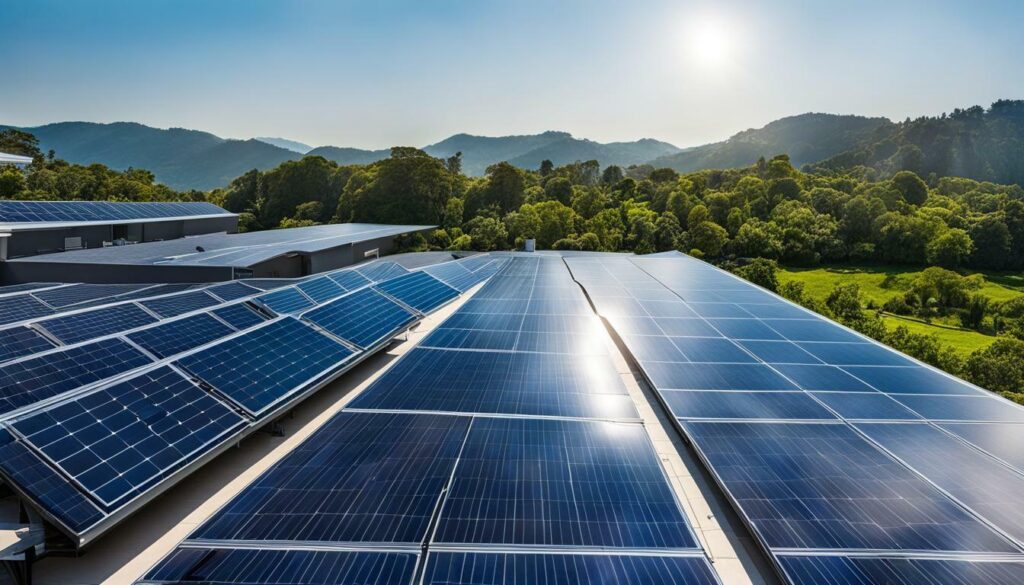
The Impact of Cool Roofs
“Cool roofs not only save homeowners money on energy bills but also help improve overall air quality and create greener, more sustainable cities.” – John Doe, Cool Roof Expert
| Benefits of Cool Roofs | Description |
|---|---|
| Reduced Peak Energy Demand | Cool roofs lower energy consumption, resulting in reduced peak energy demand and a more stable energy grid. |
| Enhanced Air Quality | By reducing the use of air conditioning and refrigerants, cool roofs contribute to cleaner and healthier air. |
| Greener Cities | Cool roofs mitigate the urban heat island effect and create more sustainable urban environments. |
When considering roofing options, it’s essential to recognize the wide-ranging benefits of cool roofs. Not only do they provide financial savings and improve the comfort of your home, but they also have a positive impact on the environment and the community at large. By embracing cool roof technology, you are taking a significant step towards a more sustainable and energy-efficient future.
Implementing Cool Roofs
When implementing cool roofs, it is essential to consider the specific needs and climate of the location. Each area has its unique characteristics that can influence the choice of cool roof technology. By taking these factors into account, you can optimize the performance and effectiveness of your cool roof. Whether you are installing a cool roof on a residential or commercial building, understanding your location’s climate is crucial.
A cool roof’s ability to reflect sunlight and absorb less heat depends on factors like temperature, humidity, and the amount of sunlight the area receives. For example, in hot and dry climates, choosing a cool roof with a higher solar reflectance index (SRI) can help reduce cooling costs and enhance indoor comfort. In humid climates, it is important to select a cool roof material with moisture resistance to prevent mold and mildew growth.
Another consideration when implementing cool roofs is the specific needs of your building. Factors such as the roof’s slope, insulation requirements, and budget constraints should be taken into account. If your roof has a steep slope, certain cool roof materials may not be suitable due to their weight or installation complexity. It is important to consult with roofing professionals who can provide expert advice tailored to your specific needs and goals.
By carefully considering the location, specific needs, and climate, you can make informed decisions about implementing cool roofs. The right choice of cool roof technology can contribute to energy savings, improved indoor comfort, and a greener future.
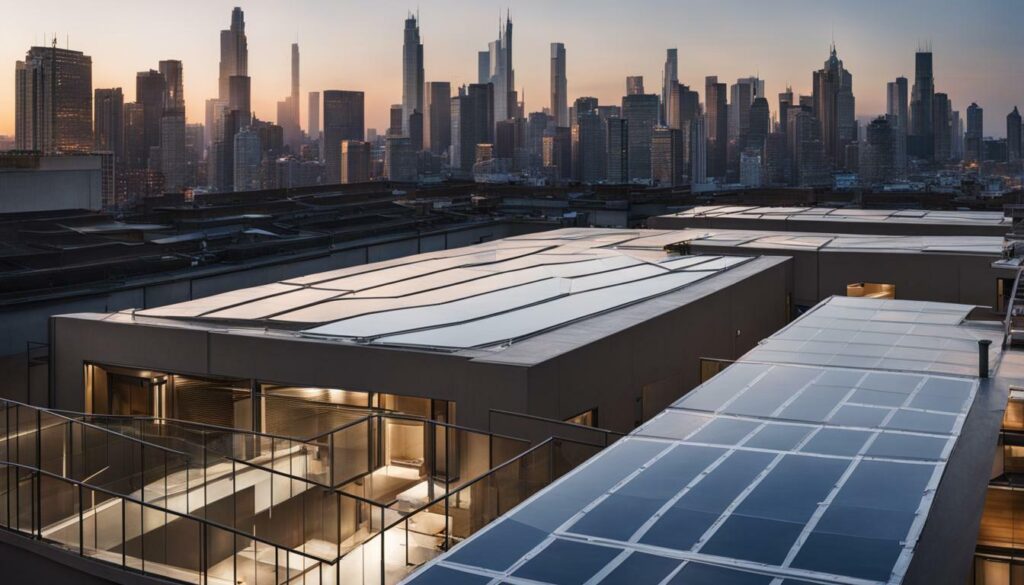
Embracing Cool Roof Technology
Embrace cool roof technology and create a sustainable and energy-efficient future. The evolution of roofing has brought exciting advancements, from smart roofs with sensors and Wi-Fi connectivity to heated roofs that keep your feet warm. Solar roofs are also gaining popularity, harnessing the power of the sun to generate renewable energy. High-tech roof insulation helps keep your home cool in the summer.
Stay on top of your roofing game with cutting-edge tools like the Roof-Dazzler 3000 and the Turbo-Nailer 5000. These advanced tools ensure optimal results in roof installation and maintenance, saving you time and effort. With the Roof-Dazzler 3000, you can achieve a dazzling roof design that stands out from the crowd. And the Turbo-Nailer 5000 provides fast and efficient nail placement, making your roofing process smoother than ever.
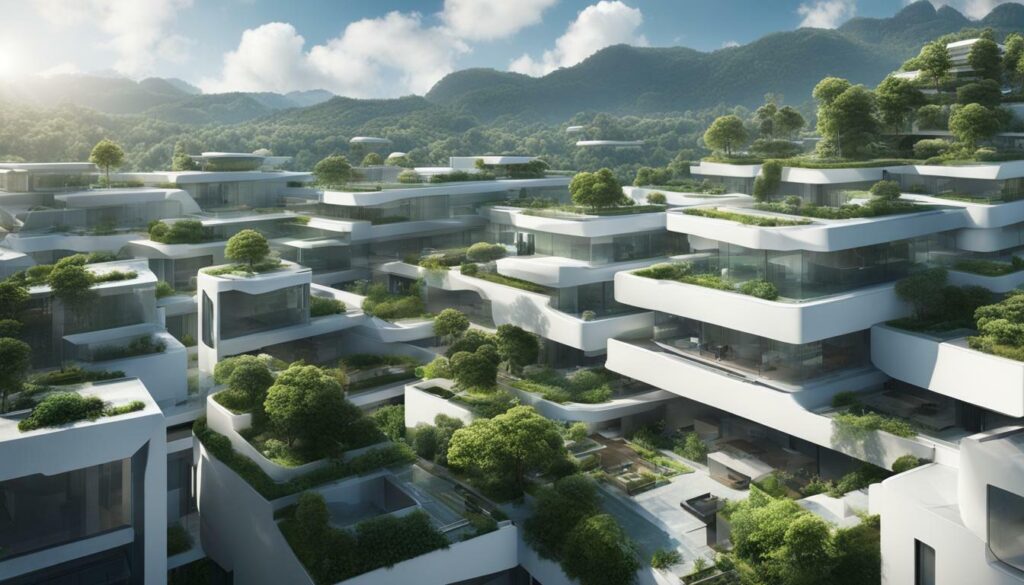
When it comes to choosing roofing materials, opt for sustainable options like metal, clay tiles, and cool roofs. Metal roofs are durable, long-lasting, and recyclable, making them an eco-friendly choice. Clay tiles offer a classic and elegant look while providing excellent insulation properties. Cool roofs, on the other hand, reflect sunlight and absorb less heat, reducing the urban heat island effect and lowering energy consumption.
The Benefits of Cool Roofs
- Reduced energy consumption: Cool roofs reflect sunlight and absorb less heat, leading to lower energy usage for cooling your home.
- Improved indoor comfort: With cool roofs, your home stays cooler in hot weather, providing a more comfortable living environment.
- Extended roof lifespan: Cool roofs experience less thermal stress, resulting in a longer lifespan compared to traditional roofs.
- Reduced peak energy demand: Cool roofs help reduce peak energy demand, relieving strain on the electrical grid.
- Enhanced air quality: By reducing energy consumption, cool roofs contribute to lower emissions and improved air quality.
- Greener cities: Cool roofs help combat the urban heat island effect, creating more sustainable and livable cities.
When implementing cool roofs, it’s essential to consider the specific needs and climate of your location. Consult with roofing professionals to determine the best type of cool roof technology for your property. Whether you own a residential or commercial building, embracing cool roof technology is a step towards creating a sustainable and energy-efficient future.
Upgrade your roofing system today and enjoy the benefits of cool roof technology – reduced energy costs, enhanced comfort, and a greener environment.
The Future of Cool Roofs
The future of cool roofs holds exciting possibilities for further advancements in technology. As we continue to prioritize energy efficiency and sustainable living, cool roof technology will play a pivotal role in creating a greener and more comfortable future. With ongoing research and innovation, we can expect even greater developments in the coming years.
One area of focus for future cool roofs is improved insulation. As we strive to reduce energy consumption, advancements in insulation materials will help keep our homes cooler in the summer and warmer in the winter. These innovative materials will not only enhance indoor comfort but also contribute to significant energy savings.
Another exciting development is the integration of smart technology into cool roofs. Imagine having a roof that can not only reflect sunlight and absorb less heat but also communicate with your smart home system. With sensors and Wi-Fi connectivity, these roofs will be able to automatically adjust their properties based on weather conditions, further optimizing energy efficiency.
Furthermore, the future of cool roofs will see an expansion of sustainable roofing materials. Metal roofs, clay tiles, and cool roofs will continue to gain popularity for their energy efficiency and long lifespan. These materials are not only better for the environment but also offer durability and aesthetic appeal.
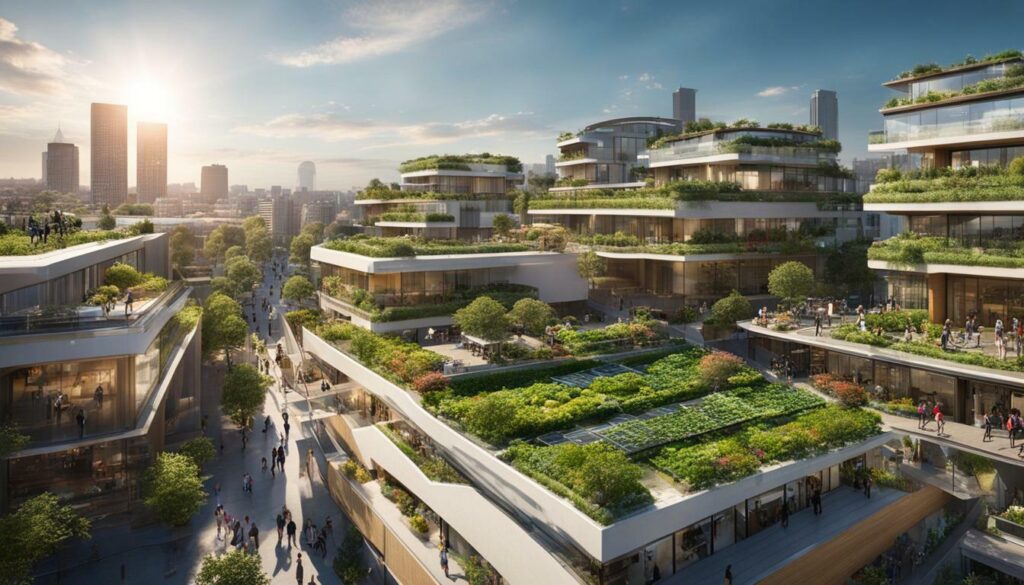
| Benefits of Cool Roofs in the Future | Future Developments |
|---|---|
| Reduced energy consumption | Improved insulation materials |
| Enhanced indoor comfort | Integration of smart technology |
| Extended roof lifespan | Expansion of sustainable materials |
| Lower peak energy demand | |
| Improved air quality | |
| Greener cities |
In conclusion, the future of cool roofs is full of promise and potential. With advancements in technology, we can look forward to more energy-efficient and sustainable roofing solutions. By embracing cool roof technology, we can contribute to a greener and more environmentally conscious future while enjoying the benefits of reduced energy consumption, improved indoor comfort, and extended roof lifespan.
Benefits of Cool Roofs for Residential and Commercial Buildings
Cool roofs offer numerous benefits for both residential and commercial buildings, ranging from energy savings to improved indoor comfort. By reflecting sunlight and absorbing less heat, cool roofs reduce the need for air conditioning, resulting in lower energy consumption and significant cost savings. In fact, studies have shown that cool roofs can reduce energy use by up to 20%, making them an attractive option for those looking to reduce their carbon footprint and save money on utility bills.
In addition to energy savings, cool roofs also enhance indoor comfort. By keeping the roof surface temperature lower, cool roofs help maintain a cooler interior environment, reducing the need for excessive air conditioning and creating a more pleasant space for occupants. This is especially beneficial in hot climates where high temperatures can make indoor spaces unbearably hot. Installing a cool roof can make a noticeable difference in maintaining comfortable temperatures inside the building, improving the overall quality of life for residents or employees.
Another advantage of cool roofs is their contribution to mitigating the urban heat island effect. In urban areas, the concentration of buildings and paved surfaces absorbs and stores heat, leading to higher temperatures. Cool roofs help counteract this effect by reflecting sunlight and reducing the overall heat buildup, ultimately leading to cooler cities and improved air quality. By implementing cool roofs on a larger scale, we can make significant progress in creating greener, more sustainable communities.
| Benefits of Cool Roofs | Residential Buildings | Commercial Buildings |
|---|---|---|
| Energy Savings | Lower utility bills for homeowners | Reduced operating costs for businesses |
| Improved Indoor Comfort | Cooler interiors during hot weather | Enhanced working environment for employees |
| Urban Heat Island Mitigation | Reduced heat buildup in cities | Improved air quality for urban areas |
Investing in a cool roof is a wise choice for both residential and commercial buildings. Not only will it provide immediate benefits such as energy savings and improved comfort, but it will also contribute to a more sustainable future. Whether you’re a homeowner looking to reduce your carbon footprint or a business owner aiming to cut operating costs, embracing cool roof technology is a step in the right direction. Make the switch today and enjoy the many advantages that cool roofs have to offer.
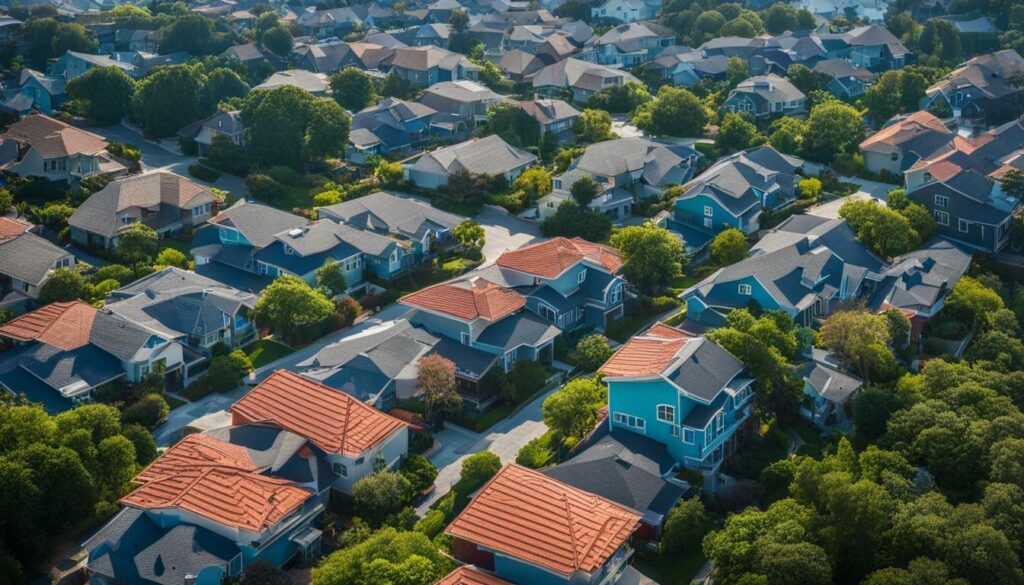
Conclusion
In conclusion, embracing cool roof technology is essential for creating a sustainable and energy-efficient future. The evolution of roofing has brought exciting advancements, from smart roofs with sensors and Wi-Fi connectivity to heated roofs that keep your feet warm. Solar roofs are also gaining popularity, harnessing the power of the sun to generate renewable energy. High-tech roof insulation helps keep your home cool in the summer.
Stay on top of your roofing game with cutting-edge tools like the Roof-Dazzler 3000 and the Turbo-Nailer 5000. Upgrade your roofing materials with sustainable options like metal, clay tiles, and cool roofs. Green roofs and living walls are also trending, providing numerous benefits like improved air quality and insulation.
Cool roofs play a crucial role in reducing the urban heat island effect and saving energy. They reflect sunlight and absorb less heat, leading to lower energy consumption, improved indoor comfort, and extended roof lifespan. Cool roofs also contribute to reduced peak energy demand, enhanced air quality, and greener cities.
When implementing cool roofs, consider the specific needs and climate of the location. Embrace cool roof technology and create a sustainable and energy-efficient future.
FAQ
Q: What is cool roof technology?
A: Cool roof technology refers to the use of roofing materials and designs that reflect sunlight and absorb less heat, leading to lower energy consumption, improved indoor comfort, and extended roof lifespan.
Q: What advancements have been made in roofing technology?
A: Roofing technology has seen exciting advancements, including smart roofs with sensors and Wi-Fi connectivity, heated roofs for added comfort, solar roofs that generate renewable energy, and high-tech insulation that keeps homes cool in the summer.
Q: Are there any innovative tools for roofing?
A: Yes, there are cutting-edge tools like the Roof-Dazzler 3000 and the Turbo-Nailer 5000 that are used in roofing to achieve optimal results in installation and maintenance.
Q: What are some sustainable roofing materials?
A: Sustainable roofing materials include options like metal roofs, clay tiles, and cool roofs. These materials promote energy efficiency and have a long lifespan.
Q: What are green roofs and living walls?
A: Green roofs and living walls are eco-friendly solutions that involve the use of vegetation on rooftops and walls. They provide benefits such as improved air quality, insulation, and enhanced aesthetics.
Q: How do cool roofs benefit the environment?
A: Cool roofs play a crucial role in reducing the urban heat island effect, saving energy, and promoting greener cities. They reflect sunlight and absorb less heat, leading to lower energy consumption, improved air quality, and reduced peak energy demand.
Q: How should cool roofs be implemented?
A: When implementing cool roofs, it is important to consider the specific needs and climate of the location. This ensures that the cool roof technology chosen is suitable for the environment and provides maximum benefits.
Q: Why should I embrace cool roof technology?
A: Embracing cool roof technology is essential for creating a sustainable and energy-efficient future. Upgrading to cool roofs can help reduce energy consumption, improve indoor comfort, and contribute to a greener environment.
Q: What does the future hold for cool roofs?
A: Ongoing research and innovation are expected to bring further developments in cool roof technology. The future holds exciting possibilities for even more efficient and advanced cool roof solutions.
Q: What are the benefits of cool roofs for residential and commercial buildings?
A: Cool roofs provide numerous benefits for both residential and commercial buildings. They can help save on energy costs, improve indoor comfort, and contribute to a more sustainable and environmentally friendly environment.
